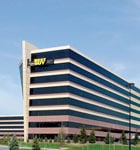Best Buy may be best known for its retail stores, packed full of fun electronic toys, but the company also is one of the nation’s most environmentally conscious retail chains. Since 2009, it’s been working toward the aggressive goal of reducing its North American carbon footprint 20 percent by 2020, primarily by reducing energy use in its 1,000 stores.
LEED certification is one element of Best Buy’s broad energy-saving strategy, but it presents a unique challenge: the company, like many big-box retailers, is faced with the task of getting not one, but hundreds, of stores certified. And that’s where Danielle Tallman, prototype and sustainability manager, focuses her efforts.
“In 2007, the USGBC began conversations with Best Buy about the idea of … getting a prototype pre-certified, then building additional stores based on that prototype,” Tallman says. “That was a great opportunity for retailers like us, so we worked with the USGBC to get our prototype pre-certified, then got subsequent stores certified through the organization’s volume-certification program.”

With a 57% reduction in energy use and an Energy Star rating of 97, Best Buy’s Richfield, MN, headquarters is the largest US corporate campus to achieve LEED Gold certification under the EBOM rating, thanks in part to Dunham’s energy expertise.
Best Buy develops specifications for architects, engineers, and developers building a new store. “You essentially incorporate as many points as possible into the prototype set of drawings,” Tallman says. “Then there’s an extensive documentation review, just as you would have with a typical LEED project, but you also have to develop an education-and-quality-control plan to show how you’re going to take this set of elements and make sure they’re performed in the same consistent manner no matter where you build a store.”
When building stores based on the approved prototype, Best Buy still has to verify that all of the elements it claimed would be included are incorporated. To do so, the retail chain assembles documentation for multiple stores and provides it to the USGBC, which then audits a certain portion of the submissions.
This method, Tallman says, creates a much lighter workload. “Because a good chunk of the documentation is approved ahead of time, when you build an actual store, you collect a slimmed-down set of information than a typical one-off project would collect,” she says. “You also pay reduced fees, with LEED certification-specific fees for each project coming in at around half a percent of the project cost.”
To date, Best Buy has certified 42 stores (with two Gold and four Silver) through the LEED for Retail Commercial Interiors and LEED Volume programs. But Tallman is quick to point out that sustainability, for Best Buy, is about more than gathering points: it’s an ongoing effort that centers around sustainable solutions, product stewardship, access to technology, and an inspired workplace. “We look at all components of a sustainability program when it comes to our buildings,” she says. For example, Best Buy has a goal of recycling one billion pounds of consumer goods by 2014, and to that end offers in-store recycling “all day, every day, as long as the store is open,” explains Leo Raudys, Best Buy’s senior director of environmental sustainability. The company is one third of the way to its goal.
The retail chain is also rolling out an enhanced enterprise energy management system (EMS) that will provide even more information and control. That cutting-edge EMS, which Best Buy developed in cooperation with a technology partner, will take many energy-management decisions (such as turning off lights and managing temperatures) out of the hands of stores to be handled remotely. “We think we’ll achieve 15-percent savings on top of the $35 billion in savings we’ve already achieved over the past three years,” Raudys says. “And those savings keep compounding, reflecting in future budgets.”

